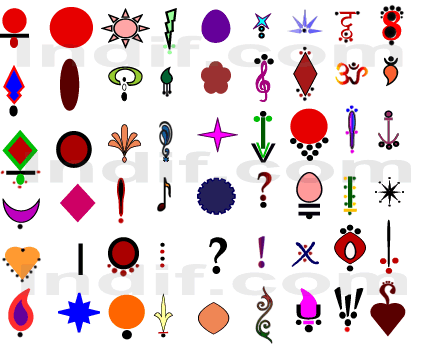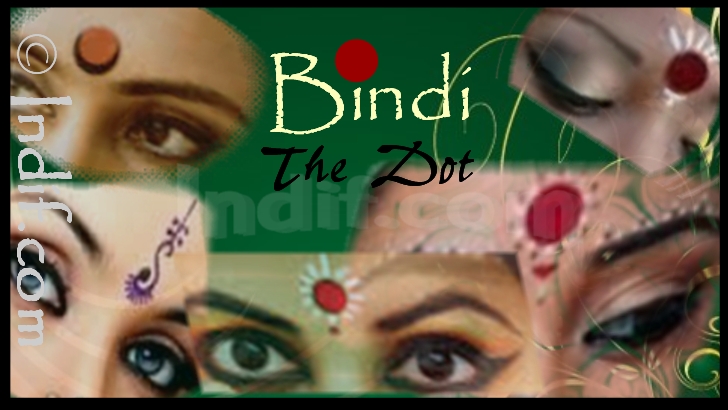The dot or bindi also known as 'tika', 'pottu', 'sindoor', 'tilak', 'tilakam', 'bindiya', 'kumkum' and by other names. Pronounced as 'Bin Dee', the word bindi is derived from the Sanskrit word bindu, which means "drop".
Bindi is an auspicious ornamental mark worn by Hindu girls and women on their forehead between the two eyes . Bindi is arguably the most visually fascinating in all form of body decoration. More than a beauty spot, the manga tika (bindi) indicates good omen and purity.It has found its way in folk-literature, poetry, sculpture and other forms of arts and literature. In olden days, all Hindu men and women wore these marks, but today, it is the women who are most faithful in wearing the bindi.
The dot has a mystical meaning. It represents the third eye od spiritual sight, which sees things the physical eyes cannot see. The forehead dot is a reminder to use and cultivate this spiritual vission to perceive this better understand life's inner workings - to see things not just physically but with this "mind's eye," as well.
Bindi - A symbol of marriage
Traditionally Bindi is a symbol of marriage, very similar to western wedding bands. A red dot on the forehead is an auspicious sign of marriage and guarantees the social status and sanctity of the institution of marriage. Bindi were worn by married women in North India in the form of a little red dot. It denotes the woman's married status in most of the North Indian communities but in South India it is a prerogative of all girls to wear a bindi. The bridegroom's make-up is incomplete without Tilak, it is applied on the groom's forehead during the wedding ceremony. No festival or puja is complete without the tilak and sindoor. Red was chosen because that color was suppose to bring good fortune into the home of the bride. The red mark made the bride the preserver of the family's honor and welfare. Over time, it has became a fashion accessory and is worn today by unmarried girls and women of other religions as well. No longer restricted in color or shape, bindis today are seen in many colors and designs and are manufactured with self-adhesives and felt.
Significance of Bindi
The very positioning of the bindi is significant. The bindi is always worn on in the middle of the eyebrows, this is believed to be the most important pressure point of the human body. This point is known by various names such as Ajna chakra, Spiritual eye, Third eye meaning 'command', is the seat of concealed wisdom. It is the centre point wherein all experience is gathered in total concentration. According to the tantric cult, when during meditation the latent energy rises from the base of the spine towards the head, this 'agna' is the probable outlet for this potent energy. The red 'kumkum' between the eyebrows is said to retain energy in the human body and control the various levels of concentration. It is also the central point of the base of the creation itself — symbolizing auspiciousness and good fortune.
Health Benefits of Bindi
Healthwise, wearing bindi between the eyebrows where the pineal glands are located. This is an important nerve center and applying sandalwood or ash keeps the nerves cool and so keeps you cool and conserves energy. In the past the Bindi was made from the yellow and red sandalwood, red and yellow turmeric, saffron, various flowers, ash, zinc oxide. All these had cooling properties in nature.
No one knows exactly when the tradition of putting a bindi started, but since centuries it is seen on the foreheads of Hindu men and women. In the past few decades, not only married women have taken up this beautiful accessory. Girls of all ages enjoy wearing a variety of styles and colors. Today, the bindi is more about the mood and occasion. They are often matched with the color clothing a person is wearing. Today, bindi is more of a fashion statement than anything else, and the number of young performers sporting bindis is overwhelming even in the West. These days bindis are available in many shapes and colors. Today, the color of your dress and the shape of your face determines the shape, size and color of the bindi you choose. Some popular motifs available are - rounf, onlong, long, triangular, cresent, long line etc.
Tips on choosing the Bindi pattern -
- For a small or narrow forehead - a small forehead appears large with an oblong shaped bindi. Place the bindi between the eyebrows.
- For a broad forehead - a broad forehead looks good with a round shaped bindi. Place the bindi in the middle.
- For a fair complexion - Red looks striking on a fair complexion.
- For a dark complexion - Pink, Orange and sandalwood colors looks prominent on a dark complexion.
- For a very darkcomplexion - Do not use red, gray or brown colors on a very dark complexion.
- For a Whitish complexion - light red looks striking on a whitish complexion.
Some Designs or Patterns of Bindi -
We here present some Bindi designs which can be made with different color liquid bindis or in combination with sticker bindis.










